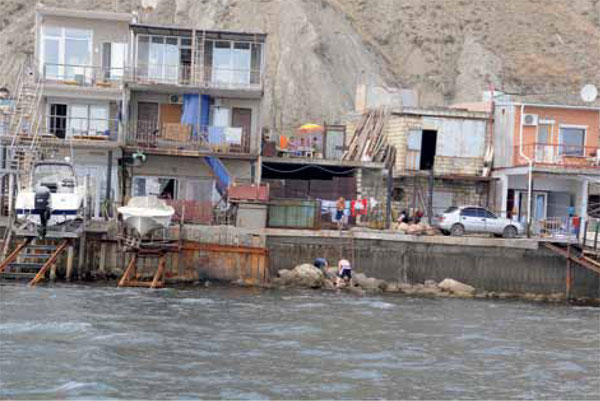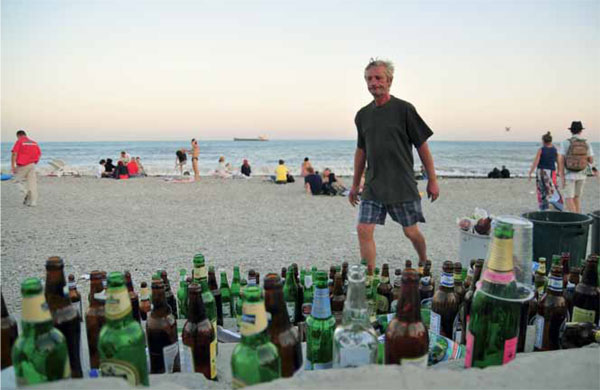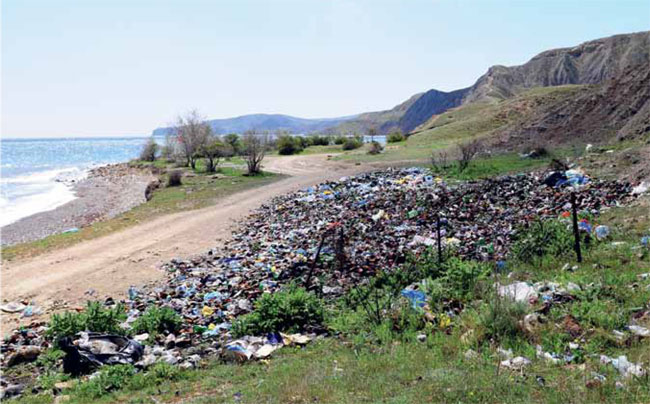After 1991, Crimea was one of the most promising regions of the newly independent Ukraine. Plenty of resorts, highly technological agriculture and a mighty military and industrial complex – all this could have been a powerful push to Crimea’s progress. Instead, the autonomous republic has been constantly degrading economically, socially and politically. Today, the peninsula is a reservation of anti-Ukrainian forces and a rudimentary soviet/Russian mental code which to this day, determines the thinking and way of life for most of the local population. As a result, its semi-criminal and semi-nomadic psychology hampers Crimea’s economic and political progress.
STABLE CHAOS
There is a stereotype about the only non-unitary part of Ukraine: that all Crimeans can’t wait to join Russia while hating anything Ukrainian on a biological level. This is partly true, but the biggest problem of the local population discovered by The Ukrainian Week is not its pro-Russian and anti-Ukrainian sentiment. It is the soviet mentality that has not faded over the two decades of its autonomy. This is reflected in socio-psychological patterns, which invariably carry with them the relevant methods of management, administrative relations and worldview.
As soon as Communist power started to waver in the late 1980s, Crimea plunged into lawlessness. “I had the impression that all young people joined gangs back then,” Oleksiy Dryhanov, a former local police officer, recalls. “There is no other part of Ukraine to compare it with, other than maybe Donbas where crime rates skyrocketed in the early 1990s. Entire regions of the peninsula turned into something akin to Harlem. Everything seemed to collapse all at once: law enforcement, welfare and the economy. Most people were completely disoriented, while the younger generation saw only criminal ways to resolve issues. Our resorts only made things worse. All old “red directors” who refused to give up profitable positions to mobs (officially known as organized criminal groups – Ed.) were eliminated. And then there were the Crimean Tatars with their unauthorized grabbing of the land that nobody was willing to give back to them on their return from exile on the verge of independence. Moreover, Crimea turned into a terminal for the illegal shipment of armament which was stolen on a massive scale from former Soviet Army arsenals and sold to hot spots, such as Abkhazia, Ossetia, Chechnya or Transnistria. In addition, the as yet unclear status of the Black Sea Fleet opened many doors to arsenals. As a result, Crimean bandits ended up with piles of weapons. These were not just guns, but also grenade launchers, machine guns, and more. All were used in their clashes. At some point, Crimea began to look like a front line with battles unfolding between gangs on the streets and dozens of casualties, while we – the police – couldn’t do anything to stop it. Many people left the police and joined these gangs, while those of us who stayed had no idea who we were subordinate to – Simferopol, Kyiv or Moscow – or what to do when every second criminal has a grenade launcher or a Kalashnikov in his hands, while you only have a service handgun (a Makarov – Ed.) and no permission to shoot without warning. I lost many colleagues back then. I don’t even want to talk about the miserable salary, paid only once in five-six months.”

Photo: Oleksandr Zakletsky
Many experts on those times claim that the Crimean chaos of the 1990s reached such catastrophic levels because the local population that had been moved to the peninsula from other parts of the former USSR did not feel that they had any roots in Crimea. In the 1990s, Crimea underwent a period of socio-political instability that was so ruinous, that to this day its population panics at the thought of any uncertainty. This is also part of the rudimentary soviet way of thinking when, having experienced terrible military conflicts, famines and the repressive apparatus under the USSR, people had just one thought in mind: let there be no war. Crimea was the most successful example of homo sovieticus breeding, hence the reason why the Party of Regions’ slogans, such as “The ruin is over – stability has been reached”, are of such great appeal to the locals.
For Crimeans, if not an obsession, the wish for stability is one of the dominating social trends. “In the 1990s, there would be almost daily shootings in my district, because the notorious bashmaki, the old shoes gang (one of the biggest Crimean organized criminal group in the 1990s – Ed.) had their ‘headquarters’ there,” Anna Pliuta from Simferopol recalls. “I have vivid memories of the curfew, the armoured vehicles in the streets, and how scary it was to leave the apartment in the evening. I remember electricity and water being turned off regularly in the late 1990s when we would live without light or a drop of water for days. That’s why I want one thing for my kids: no shooting, food on the table and I want to be able to plan this at least one-two months in advance. The rest is not important. I’m a small person and I can’t change anything, therefore it’s better to vote for the people I’ve already seen – for those who are already in power. It’s better to keep a low profile.”
UNDER THE ROOF OF CORRUPTION
The destruction of Crimean organized crime in the late 1990s, authorized by Kyiv was, to a large extent, an illusion. Only the worst thugs who did not recognize any power, including that of the “old shoes” gang, were killed or imprisoned. The rest fit perfectly into the system and ended up with protection from above. One example is the story of the Party of Regions’ MP Oleksandr Melnyk who was linked to Seilem, the biggest Crimean organized criminal group. He was released in 2006 – ex-Interior Minister Yuriy Lutsenko said it was per personal request of the then Prime Minister Viktor Yanykovych. People cannot help but see this system that also shapes a relevant worldview.
This near-criminal archetype of thinking that one should “deal with issues” on the one hand and “keep a low profile” on the other, to this day, is victoriously being recreated in the autonomous republic. Sociological surveys show that it is Crimeans, particularly those aged over 35, who are the most reluctant to be involved in the protection of their rights or any protests in Ukraine. The infamous problem of the unauthorized grabbing of land is a good illustration of the system of corruption in law.
“Of course, there were plenty such incidents in the 1990s,” a member of the Mejlis (the central executive body for Crimean Tatars – Ed.) says off-record. “Our people (Crimean Tatars who returned to Crimea from deportation – Ed.) arrived and were given no land, so they were forced to occupy it on their own. Lately, however, this has turned into a business of sorts. Some Tatars now do this to subsequently re-sell the land, and they will not necessarily sell it to Tatars. According to statistics, people of Slavic origin now grab more land, assisted by the local authorities that find ways to come to terms with the Tatars and big business owners, especially Russian, interested in such deals.”

Photo: Andriy Yevdokymenko
According to statistics, up to 40% Crimeans work in the recreation sector and a further almost 20% are involved in related industries. “We all work for the resort here,” says Yalta-based Oleksiy Surkov, a one-time research associate. “We don’t need any conflicts here. It’s better to “take care of things” than actually resolve problems. It’s important to have a nice picture so that people come here every year and spend their money on vacations.”
THE NOMAD SYNDROME
However, this wish to keep the resort business untouched does not correlate with the fact of its stagnation in Crimea. In other words, it welcomes its 1.5-2mn vacationers a year, but the number is gradually shrinking. Another important fact is that most of these vacationers are either Ukrainians or tourists from post-soviet states. In the absence of any strategic development in the tourist infrastructure, foreigners are not coming to Crimea, and nor will they. In the first place, this is because of the way the local population treat their own land, which appears never to have really become their own.
A typical example: Tours around Crimea, which actually has many historical and natural attractions, is a good way to earn an extra penny during the summer, so anyone and everyone become tour guides. Guides monotonously mutter a set of phrases they learned in a shabby guidebook while throwing a candy wrapper on the ground and not thinking that trash on his tour route is hardly inviting for potential visitors to the peninsula. Moreover, any question that have no answers in the guidebook in his pocket, leaves the guide confused, since with very few exceptions, he is just earning money and has nothing to do with the object, landscape or building he is talking about.
“95% of the locals don’t love the land they live on, they just use it,” says traveler Serhiy Vasiuta from Feodosia. “They are not interested in its history, they don’t care about nature. All they want is to make money during the holiday season; right now and with the least amount of effort. They don’t care about tomorrow. My impression is that the soul of many Crimeans is still host to a nomad, whose goal is to squeeze all the juice out of the land it has come to, and move on to exploit yet another part of the territory. No wonder, since most of these people arrived in Crimea just two generations ago. Everything was done for them, so they don’t feel a deep connection to the land. They don’t see it as the only land, given by God for ever, which they have to care for and love because they will have no other. Without this, there will be no normal European type of development. Still, conflicts over this very land with Tatars could lead to killings, but they never invest a penny to develop their territory and mercilessly exploit the almost dead soviet infrastructure. They are capable of ploughing through an ancient town with an excavator, thereby earning hundreds of millions of dollars in the future, just to build yet another shabby hotel where they will rent out rooms to vacationers. They will serve bad food in a café, realizing that nobody is going to visit them next year. However, they would rather earn their 10 cents today rather than UAH 100 tomorrow.”

Photo: Andriy Yevdokymenko
QUASI-RUSSIANS
The latest census shows that 58% of Crimeans are Russians. Local experts Tetiana Huchakova and Andriy Klymenko believe that the peninsula has become a “Russian autonomy” which has now been cemented through the notorious language law sponsored by the Party of Regions’ MPs, Kolesnichenko and Kivalov. However, it appears that in the Crimean reality, pro-Russian sentiment is merely nostalgia for the soviet lifestyle rather than a desire for annexation to modern Russia. A demonstrative fact of this is that only about 1,000 Crimeans have taken advantage of the programme for re-settling “compatriots”, launched by Moscow in 2007. The only connection between modern Crimea and Russia is relatives, a “common past” and a bunch of tourists from Russia, who fill the beaches of Southern Crimea every year. Meanwhile, the younger generation of Crimeans has no problem speaking both Russian and Ukrainian and see themselves as fully-fledged citizens of Ukraine.
“The pro-Russian orientation of the Crimean population is reminiscent of the pro-communist views of most former soviet citizens,” explains psychologist Andriy Strutynsky. “They all declare it but deep eown, do not actually believe it. Over the past 20 years, they have grown used to seeing Kyiv as their capital, not Moscow. Moreover, most have not experienced any pressure on the Russian culture or language. Notably, most Crimeans still vote for the Party of Regions, not the Russophile Russian Bloc-like parties. Kyiv’s timid and feeble attempts to switch record-keeping into Ukrainian were one big failure. Thus, the locals are actually concerned with quality of life and the infamous stability rather than language.”

